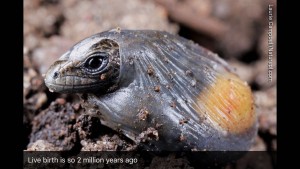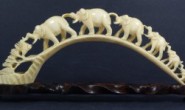WHICH came first, the lizard or the egg?
In at least one species, we have an answer: the lizard first gave birth to live young and only later re-evolved the ability to lay eggs. It’s a rare example of a complex lost trait re-emerging in a species.
re-evolved 再进化
trait 特点
re-emerging 重新出现的
The common lizard is found across Eurasia from Ireland to Japan. Its name Zootoca vivipara means “live-bearing” in both Greek and Latin, and as you might expect, it gives birth to its young.
But there are exceptions. Two small populations on the edge of the lizard’s range lay eggs. One of these subspecies is found near the border between Spain and France, the other in the southern Alps.
Biologists had assumed these subspecies were remnants of an egg-laying ancestral population from which the live-bearers evolved – something that seems to have happened over 100 times in reptiles. But genetic data from the lizards did not fit this simple story.
eurasia 欧亚大陆
remnant 剩余部分
live-bearing 胎生 egg-laying 产卵 (这两个都是名词,表示动物类别)
如果要问某些动物是胎生还是产卵的呢,怎么办?
Do penguins lay eggs? Yes, penguin species lay two eggs at on time. Howerver, the king and emperor penguins lay a single large egg. They incubate(孵化) their eggs by resting them on top of their feet and covering them with the lower part of their bellies.
Do foxes lay eggs? No, foxes don’t lay egg instead they give birth to live young.
One suggestion was that live-bearing evolved twice. Another was that egg-laying reappeared in one group, but this was thought to be unlikely.
“There is not really any consensus,” says Kathryn Elmer of the University of Edinburgh, UK. So her team collected 76 lizards from around Europe and carried out thorough genetic studies, looking at over 200,000 sites in the genome. They used this data to build a detailed family tree of common lizards.
genome 基因组
The tree shows the egg-laying lizards in the southern Alps are a remnant of the ancestral group. Live-bearing lizards evolved once from this ancestral population and split into several groups. In one group, egg-laying reappeared, creating the Spanish population (bioRxiv, doi.org/cgx8).
“I consider this strong evidence of regaining egg-laying,” says April Wright of Southeastern Louisiana University. In 2015 she found hints of three other cases of egg-laying re-emerging in lizards.
We don’t know how or why common lizards began to lay eggs again. It must have happened recently, as these lizards only became live-bearing around 2 million years ago. Perhaps the genetic program used in egg-laying lay dormant for that time, then was reactivated.
However, snakes called sand boas may have re-evolved egg-laying after 60 million years. The old program probably didn’t last this long, so sand boas may have evolved this trait from scratch.
It is becoming clear that evolution often changes direction. On one Galapagos island, finches evolved thicker beaks during a dry period when small seeds were rare, then swapped to thin beaks when the climate became wetter.
But it is a different matter for evolution to go into reverse long enough for a trait as complex as egg-laying to reappear. “I think it’s quite uncommon,” says Elmer.
It does happen, though, contrary to a claim by 19th-century biologist Louis Dollo. His hypothesis, that such reversions are impossible, is wrongly called Dollo’s law.
reverse 反转 颠倒
contrary to 与…相反
hypothesis 假说
This article appeared in print under the headline “Lizards do evolutionary U-turn over babies”
Michael Le Page
转载请注明:乐课堂 » 读报:Lizards re-evolved eggs after 2 million years of live births




